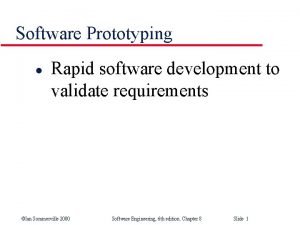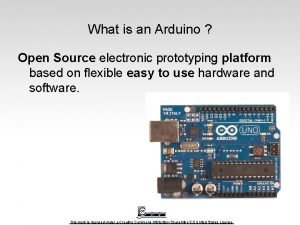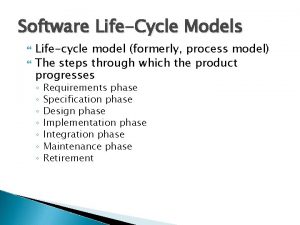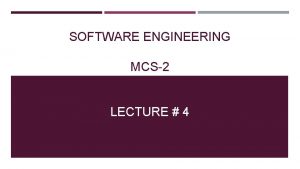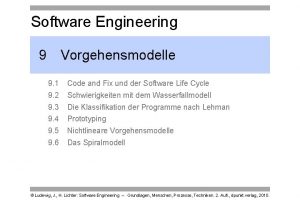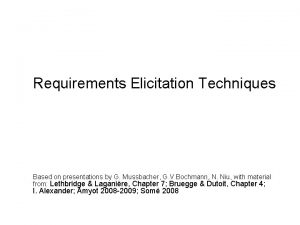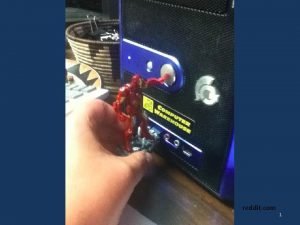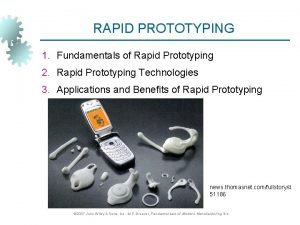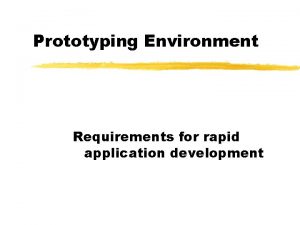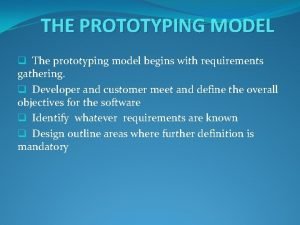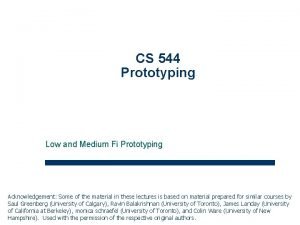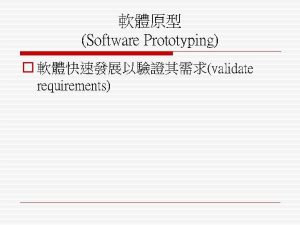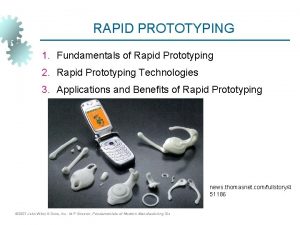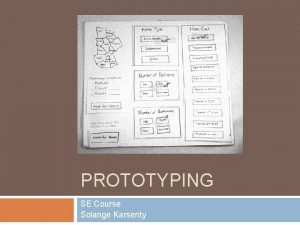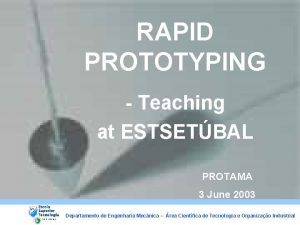Technology Development Prototyping Division ANGC 5 RIRP Portfolio

























- Slides: 25

Technology Development & Prototyping Division ANG-C 5 RIRP Portfolio Update Presented to: REDAC Date: August , 2014 Federal Aviation Administration

Runway Incursion Reduction Program (RIRP) Why do we do what we do? • FAA Mission Needs Statement 323 (circa 1998): • Runway Incursions (RIs) are a major problem affecting the safe operations of the nation’s airports. • Administrator’s Flight Plan 2006 – 2010 • Objective 3: Reduce the risk of runway incursions • Destination 2025 (2011) • 2018 Performance Metrics: Maintain the rate of serious runway incursions at or below 20 per 1000 events. • NTSB Recommendation A-91 -30 • calls for the FAA to implement equipment aimed at reducing runway incursions August 2014 Federal Aviation Administration 2

Runway Incursion Reduction Program (RIRP) Why do we do what we do? March 27, 1977: Fatal collision between two Boeing 747 passenger aircraft on the runway of Los Rodeos Airport on Tenerife, one of the Canary Islands. This crash killed 583 people, making it the deadliest accident in aviation history. August 27, 2006: Comair Flight 5191 Lexington, KY, to Atlanta, GA, crashed on takeoff, just past the end of the runway, killing all 47 passengers and two of the three crew. The aircraft was assigned Runway 22 for the takeoff, but used Runway 26 instead. August 2014 Federal Aviation Administration 3

Runway Incursion Reduction Program (RIRP) Why do we do what we do? April 24, 2014: Two planes nearly collided at Newark Liberty International Airport. United Express Flight 4100 was cleared to take off on runway 4 R at the same time United Airlines Flight 1243 was landing on the intersecting Runway 29. The two aircraft passed within yards of each other. July 6, 2014: A passenger jetliner preparing to leave Barcelona’s El Prat airport taxied across a runway where another was about to land, forcing the arriving plane to abort its landing and climb sharply to avoid a possible disaster. August 2014

Runway Incursion Reduction Program (RIRP) Projects • Runway Status Lights (RWSL) - transferred to PMO for implementation • Final Approach Runway Occupancy Signal (FAROS) - Discontinued • Low Cost Ground Surveillance (LCGS) - Cancelled by JRC • ADS-B Integration with LCGS - Cancelled by JRC • Enhanced FAROS (e. FAROS) - June 2014 Flight Check at BOS • Runway Safety Assessment (RSA) – Market Survey Completed August 2014 Federal Aviation Administration 5

Low Cost Ground Surveillance (LCGS) RIRP Portfolio Update Presented to: REDAC Date: August , 2014 Federal Aviation Administration

LCGS Pilot Program History and Status • • • In August 2007, Runway Safety Call to Action identified LCGS as potential technical solution to increase in Runway Incursions Runway Incursion Reduction Program Office requested LCGS Investment Analysis Readiness Decision (IARD) from the Executive Council on May 26, 2009. ATO EC delayed making a final decision; EC met again on July 7, 2009, and made the following decision: • • • Directed team to continue with contract awards for the prototype systems Directed team to operate the prototype systems for two years Directed team to return to the EC with results of the operational evaluation • JRC meeting 6/19/2013 determined that LCGS not viable as a program • All 5 sites were powered down by 09/01/2013 • All LCGS displays were removed from ATCT cabs as of 9/30/2013 • All LCGS cameras were removed from ATCT and radar towers as of 9/30/2013 Final equipment and infrastructure inventory and bar coding was completed as of 11/01/2013 • • Schedule for LCGS infrastructure removal has been developed Low Cost Ground Surveillance (LCGS) August 2014 Federal Aviation Administration

Notional Removal Schedule August 2014 Federal Aviation Administration 8 8

Steps For Site Breakdown 1) Removal/Relocation of existing equipment racks located in shelter 2) Removal / crating of existing radar equipment located in shelter, including the disconnection of radar waveguide/transceiver/motor controller 3) Removal of electrical conduits between LCGS radar tower and shelter 4) Removal of copper ground leads to ground counterpoise 5) Removal of Ice Bridge connecting LCGS tower to shelter 6) Pull back of FAA single mode fiber from the shelter back to nearest pull box 7) Termination of existing power feed to FAA ATCT location (This will require support from the local Service Area) 8) Installation of Battery Operated Obstruction lights on LCGS radar tower until tower can be removed August 2014 Federal Aviation Administration 9 9

Enhanced Final Approach Runway Occupancy Signal (e. FAROS) RIRP Portfolio Update Presented to: REDAC Date: August , 2014 August 2014 Federal Aviation Administration 10

Enhanced Final Approach Runway Occupancy Signal (e. FAROS) Enhanced-Final Approach Runway Occupancy Signal (e. FAROS) uses surface surveillance with augmented safety logic to provide a visual warning to pilots on final approach that the runway is occupied and unsafe for landing. It does this by flashing the Precision Approach Path Indicator (PAPI) lights. AJW-14 is providing design and engineering support for the development and implementation of e. FAROS at RWSL test locations Partners / Stakeholders • • Air Traffic Controllers AJW-14 Airport Authorities (DFW, BOS) Local Tech-Ops personnel August 2014 Federal Aviation Administration 11

Milestone Schedule FY 14 Milestones Develop quicklook report on shadow operations testing of the prototype e. FAROS system at BOS. Q 1 Q 2 Q 3 Q 4 Complete installation of the FPAPI units at BOS. Complete Conduct flight check of the FPAPI units installed at BOS, and commence 90 -day Operational Evaluation of the prototype e. FAROS system at BOS Complete Flight check Completed 06/22/2014 Develop a Preliminary Requirements Document (PRD) document, and commence the coordination of the Cost Benefits Analysis (CBA) document for e. FAROS IARD. August 2014 Federal Aviation Administration 12

FY 14 e. FAROS Activities Completed to date: • Installed remaining FPAPI mod kits and COM at BOS – Apr/May 2014 • Conducted ATC training and pilot outreach for e. FAROS at BOS – May/Jun 2014 • Conducted Flight Check and commence Operational Evaluation Testing (OET) of e. FAROS at BOS – Jun 21 -22, 2014 Planned: • Publish initial Preliminary Requirements Document (PRD) for e. FAROS – Sep 2014 • Publish updated Cost-Benefit Analysis (CBA) for e. FAROS – Sep 2014 • Commence “live” Op. Eval Oct 2014 August 2014 Federal Aviation Administration 13

Surface Safety Initiatives Working Group Runway Safety Assessment Market Survey for RI Reduction Technologies RIRP Portfolio Update Presented to: REDAC Date: August , 2014 Federal Aviation Administration

ANG-C Market Survey - Overview • ANG-C 5 issued a Market Survey on July 23, 2013 for Runway Incursion Reduction Technologies (Contract Opportunity ID: 14673). • The Market Survey solicits input on feasible technologies from industry partners and interested vendors. This survey is not a formal contract solicitation and is not intended to result in a contract award. • The intended outcome of the Market Survey is to evaluate one or more technologies which may be applied, or enhanced through additional research, to prevent runway incursions. • Market Survey closed on Aug 23, 2013; a total of 30 qualifying responses were received. August 2014 Federal 15 Aviation Administration 15

ANG-C Market Survey - Assessment • Evaluation of the responses was conducted from 10/31/13 to 12/6/13. • The responses received were evaluated by a team of 8 FAA employees and contractors from ANG-C and AJI, consisting of SME’s in: – – ATC Engineering & Technology Program Management Runway Safety • The outcome of the evaluation process is focused on categorizing the responses by: – the technical maturity of the proposal – research viability within a 3 -year timeframe August 2014 Federal 16 Aviation Administration 16

Market Survey Evaluation Team Recommendations August 2014 Federal Aviation Administration 17

Rockwell Collins Surface Guidance System/Digital Routing & EVS This proposal presented multiple technologies for DTPI including digital taxi routing and conformance, HUD and EVS. This system requires displays in the cockpit, and the vendor has already developed some of that technology. Some overlap exists with SURF IA, but it is far enough removed to warrant short term consideration. August 2014 Federal 18 Aviation Administration 18

FAA Developed Controller Memory Aids Runway Incursion Prevention Device – The system is a memory aid for alerting controllers about locked-out runways that is being tested at MKC and MLI airports. Closed Runway Operations Prevention Device – Voice recognition system being developed by MITRE in collaboration with FAA Terminal Requirements. August 2014 Federal 19 Aviation Administration 19

Northrop Grumman Safety Decision Support Tool This system requires surveillance and voice recognition, technologies which already exist. It could be subjected, in the shorter term, to testing at ASDE-X equipped airports. August 2014 Federal 20 Aviation Administration 20

Qineti. Q North America Runway Incursion Alerting System RIAS is a layered approach using incremental surveillance sources such as DAS (Acoustic), Thermal cameras, and millimeter wave radar. The system is currently under testing by Qineti. Q at PVD, and more recently at Potomac (VKX). August 2014 Federal 21 Aviation Administration 21

Intelli. DAR Searidge Technologies This system is based on real time video capture and processing for zone detection. It is primarily a surveillance tool with HMI capabilities for ATC, and is already being used in gate areas of airports in Canada. It is currently under evaluation for Non-Movement Area (NMA) application at WJHTC. August 2014 Federal 22 Aviation Administration 22

Embry-Riddle Aeronautical University – INSPIRE – Winner of FAA Design Competition 2013 that addressed Runway Safety/Incursions – Provides navigational guidance by converting taxi instructions through the use of voice recognition software into a laser projection displayed directly on the windshield. – Designed to increase pilot situation awareness (SA); targeted at GA aircraft. August 2014 Federal 23 Aviation Administration 23

MIT Lincoln Labs Small Airport Surveillance Sensor (SASS) – Uses small, non-rotating antenna arrays and digital processing capabilities – Provides secondary surveillance for non-ADS-B equipped aircraft – Supports surveillance & validation for ADS-B equipped aircraft – Supports Mode S data link capability (e. g. , TIS-B) & UAT – Team plans to investigate whether this technology could be adapted to provide surface safety benefits. August 2014 Federal 24 Aviation Administration 24

FAA - Advanced Concepts and Technology HUD technology in the ATCT – Study to re-evaluate the use of modern HUD technology in the ATCT. – System could provide air traffic controllers with a real-time, user selectable source of meteorological, airport surface, and runway safety information displayed on the ATCT glass that is head-up and continually in their field of view (FOV) and scan. August 2014 Federal 25 Aviation Administration 25
 Rapid throwaway prototype
Rapid throwaway prototype Rad design workshop
Rad design workshop Mission statement examples for students
Mission statement examples for students Short division vs long division
Short division vs long division Synthetic division examples with answers
Synthetic division examples with answers H.c.f
H.c.f 6-5 dividing polynomials
6-5 dividing polynomials Csp
Csp Project portfolio management process steps
Project portfolio management process steps Conclusion for portfolio assessment
Conclusion for portfolio assessment Personal info form
Personal info form Stages of portfolio development
Stages of portfolio development Formulas for career success: portfolio development
Formulas for career success: portfolio development Software development company portfolio
Software development company portfolio Open source electronics prototyping platform
Open source electronics prototyping platform Compare stl and slc file format
Compare stl and slc file format Object oriented life cycle model
Object oriented life cycle model Prototyping process in software engineering
Prototyping process in software engineering Inkrementell-iteratives vorgehensmodell
Inkrementell-iteratives vorgehensmodell Prototyping elicitation technique
Prototyping elicitation technique Paper prototyping video
Paper prototyping video Define rapid prototyping
Define rapid prototyping Liquid based rapid prototyping system
Liquid based rapid prototyping system What are the benefits of prototyping
What are the benefits of prototyping Prototyping definition
Prototyping definition Prototyping involve compromises
Prototyping involve compromises
